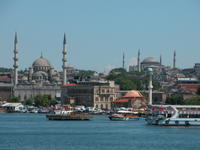The "sea-point-of-view" characterizing Istanbul's identity




Above are few pictures I've taken from various points of views in Istanbul (Galata, Topkapi, Golden Horn). Click to enlarge.
The following is some of my notes "taken on the spot" last summer in Istanbul... a truly fascinating city.
The Imperial Mind: Overseeing the Territory
The sea as an uncontrollable space is an attractive challenge: once you feel you control the space you feel ou have surpassed the controllable space. The idea of seascape is crucial. The act of overlooking the sea is best betrayed in Istanbul: a game of eye control centred around the sea: a key feature is the balcony-phenomenon either in its more manifested cases that is religious imperial buildings (specifically Suleymaniyya and Yeni Camii) or in its relatively more discrete form the secular imperial buildings (Topkapi and Galata). The reproductions of Istanbul mirrors the architectural-eye-control-point of view by singling out them as if seen themselves from the sea from the different points of view: in a certain sense recognizing their “act”.
There is clearly a purely architectural genealogy of this: Bursa. Still even in Bursa the very idea of the eye-control of space is obvious as ad riving rule. In this case, the earliest imperial experimentation of the empire, the eye control was linked to land-territorial ambissions. As Hajji Khalifa points out the conquest of Istanbul opened the experience of the sea to the Ottomans. In other words if the landscape was the focus of the pre-imperial (or better, the genesis of the imperial mind) eye-control-of space-game, the imperial mind in its essence was contemporary with the discovery of the doors of the sea. Pre-imperial land oriented, Imperial sea-oriented eye. Obviously the discovery of the seacape did not cancel the landscape dive since its very reason d’etre is still there: land conquest.
Side Note: the understanding of part of Sinan’s architectural contribution should be made on this basic visual game: architecture not only as an abstracted (from the territory) project reduced to plans but also as a visual experience suggesting POINTS OF VIEW....
Still there has to be better explanation of the Persian limits in the visual experience focused more on “past-distant” territorial experiences rather than the Ottoman orientation to contemporary history.
[Istanbul summer 2005]


<< Home